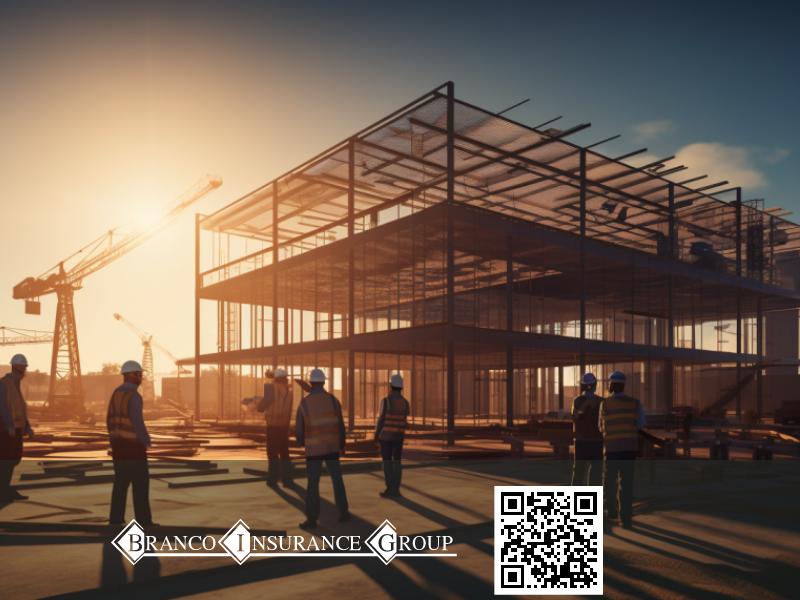Have you ever wondered about the risks faced by architects and engineers and how they manage their professional liabilities? These design professions are not immune to legal challenges, such as allegations of negligence or design flaws.
This blog will unravel the intricacies of architects and engineers professional liability insurance, offering insights into coverage options, benefits, cost factors, and more. Stay with us as we guide you through this complex yet essential aspect of architectural and engineering practice!
Key Takeaways
- Architects and engineers face unique risks and liabilities in their line of work, making professional liability insurance crucial for financial protection against allegations of negligence or design flaws.
- Professional liability insurance provides coverage for legal costs and damages, claims expertise and support, and reputation preservation, as well as coverage for subcontractors and consultants.
- Coverage options for architects and engineers include professional liability insurance (errors and omissions insurance), general liability insurance, errors and omissions insurance (professional liability insurance), and cyber liability insurance.
- Having professional liability insurance not only meets contractual requirements but also fosters trust between professionals and clients while positioning them more competitively within the marketplace.
The Importance of Professional Liability Insurance for Architects and Engineers
Architects and engineers face unique risks and liabilities in their line of work, making it crucial for them to have professional liability insurance. This type of insurance protects them from allegations of negligence or design flaws, helps meet contractual requirements, and provides peace of mind knowing they are financially protected against potential legal costs and damages.
Understanding the unique risks and liabilities faced by architects and engineers
In the architecture and engineering profession, individuals are often met with a multitude of unique risks and liabilities. This can range from potential design flaws to inadequate risk assessments that could result in construction delays or even structural damage.
These complex risks are an everyday part of their work, emphasizing the necessity for comprehensive insurance coverage.
Financial losses can be substantial within this industry due to these unpredictable factors. Claims alleging negligence or misrepresentation can surface unexpectedly, leaving architects and engineers vulnerable to significant costs if they lack suitable protection.
This is why professional liability insurance plays such a crucial role in shielding them from financial pitfalls related to diverse exposure scenarios inherent in their line of work.
Protecting against allegations of negligence or design flaws
In the complex world of architecture and engineering, there are unique risks, including allegations of negligence or design flaws. These claims can erupt from a range of situations – maybe a specification was misinterpreted in an architectural plan, or perhaps an overlooked element in an engineer’s calculations resulted in structural issues.
This is where professional liability insurance steps into safeguard architects and engineers.
This type of insurance coverage serves as the frontline defense against alleged errors, oversights, and even accusations of failing to fulfill promised services. It not only provides invaluable protection against legal proceedings arising from alleged wrongdoings but also shields professionals from the financial setbacks that these lawsuits might trigger.
With such comprehensive protection on hand, architects and engineers can keep their focus squarely on what they do best: bringing innovative designs to life while maintaining the integrity of their professional reputation.
Meeting contractual requirements
Meeting contractual requirements is a crucial factor for architects and engineers seeking professional liability insurance. These professionals often work on projects that involve hefty contracts, outlining the scope of services to be provided.
In many situations, these contracts stipulate the need for professional liability insurance as a prerequisite to engage in client services. This mandated coverage showcases duty of care, providing assurance that potential legal liabilities from design errors or construction defects will be effectively managed and mitigated.
Holding such an insurance policy not only safeguards against financial losses due to claims but also fosters trust between building design professionals and their clients, positioning them more competitively within the marketplace.
Coverage Options for Architects and Engineers Professional Liability Insurance
Architects and engineers have several coverage options for their professional liability insurance, including professional liability insurance, general liability insurance, errors and omissions insurance, and cyber liability insurance.
Professional liability insurance
Professional liability insurance, also known as errors and omissions (E&O) insurance, is a crucial form of coverage for architects and engineers. It provides protection against allegations of negligence in the performance of professional services.
With this insurance, design professionals can defend themselves and their firms against claims alleging design flaws or defects. In the event of accusations of professional negligence, professional liability insurance covers legal fees, court costs, and settlements.
It offers peace of mind knowing that you have financial protection from potential lawsuits that could otherwise be financially devastating to your firm. Don’t overlook the importance of obtaining professional liability insurance to safeguard your career and reputation as an architect or engineer.
General liability insurance
General liability insurance is a crucial coverage option for architects and engineers looking to protect their professional practice. This type of insurance provides essential protection against claims related to design errors, construction defects, professional negligence, or other errors or omissions.
With general liability insurance, architects and engineers can safeguard themselves against potential legal and financial risks associated with their work. It covers not only the expenses related to the claim but also any attorney’s fees and expert testimony that may be necessary.
Having general liability insurance is highly recommended for architects and engineers to ensure peace of mind while practicing their profession confidently.
Errors and omissions insurance
Errors and omissions insurance, also known as professional liability insurance, is a crucial coverage option for architects and engineers. This type of insurance protects against claims made by clients alleging unsatisfactory work or negligence.
It provides coverage for design errors, construction defects, professional negligence, and other types of errors or omissions that may occur in the course of your work. With professional liability insurance, you can have peace of mind knowing that your business is protected financially from costly legal expenses associated with defending yourself against these claims.
Additionally, this coverage helps preserve your reputation in the industry by demonstrating your commitment to delivering high-quality work. By partnering with an insurance provider, who specializes in tailored coverage for architects and engineers, you can ensure comprehensive protection specific to your unique needs.
Cyber liability insurance
Cyber liability insurance is a crucial coverage option for architects and engineers seeking professional liability insurance. In today’s digital age, businesses are increasingly vulnerable to cyber risks, including data breaches and network security failures.
Traditional insurance policies do not typically provide coverage for these first or third-party cyber costs. Cyber liability insurance offers protection against the financial consequences of cyber attacks, such as lost income and legal expenses related to data breaches or malware infections.
With this coverage in place, architects and engineers can safeguard their business against the potentially devastating impacts of cyber threats.”.
Key Features and Benefits of Professional Liability Insurance
Professional liability insurance offers architects and engineers key features such as protection against legal costs and damages, claims expertise and support, reputation preservation, as well as coverage for subcontractors and consultants.
Protection against legal costs and damages
Professional liability insurance provides essential protection for architects and engineers by safeguarding their businesses against the potentially devastating costs associated with legal claims.
In the event of a lawsuit arising from alleged professional mistakes or negligence, this coverage can help cover legal expenses and damages, ensuring that your firm’s financial stability is preserved.
With comprehensive coverage for professional liabilities, such as errors and omissions in design or project management, architects and engineers can mitigate the risk of costly litigation while focusing on delivering exceptional services to their clients.
Claims expertise and support
With professional liability insurance for architects and engineers, claims expertise and support are invaluable. In the event of a claim or lawsuit, having an insurance provider with extensive knowledge and experience in handling such cases can make all the difference.
They can guide you through the process, providing legal protection for your professional services. Whether it’s defending against allegations of negligence or design flaws, or navigating complex contractual requirements, their expertise ensures that you have someone on your side to help protect your reputation and financial well-being.
Don’t underestimate the importance of claims expertise and support when considering professional liability insurance – it’s a crucial aspect of safeguarding your business.
Reputation preservation
Professional liability insurance plays a crucial role in preserving the reputation of architects and engineers. In the highly competitive architectural industry, maintaining a stellar reputation is vital for attracting clients and winning projects.
By having professional liability insurance coverage, architects and engineers can protect themselves against claims filed by dissatisfied clients. These claims can arise from alleged design flaws or negligence in project execution, potentially resulting in costly lawsuits.
The coverage provided by professional liability insurance not only safeguards architectural firms from financial losses but also helps to maintain their professional standing by demonstrating their commitment to accountability and quality service.
Coverage for subcontractors and consultants
Professional liability insurance for architects and engineers provides valuable coverage not only for the professionals themselves but also for subcontractors and consultants. This means that if you work with subcontractors or hire consultants to assist on a project, their liability risks can be covered under your policy as well.
This coverage is important because it helps protect all parties involved in the project from potential claims arising from errors, omissions, or negligence in professional services provided.
So whether you’re an architect, engineer, or subcontractor/consultant working in the construction industry, having appropriate coverage is crucial for peace of mind and financial protection.
Determining the Right Coverage for Architects and Engineers
Determining the right coverage for architects and engineers is crucial to ensure comprehensive protection against potential liabilities. Read on to learn how to evaluate project size, assess contractual requirements, and compare policy limits and deductibles.
Evaluating project size and complexity
Determining the right coverage for architects and engineers requires a thorough evaluation of the project’s size and complexity. Here are key factors to consider:
- Type of Project: Assess whether the project involves residential, commercial, or industrial structures. Each type carries different risks that may affect the coverage needed.
- Scale of Project: Consider the size of the project in terms of square footage, number of floors, or number of units. Larger projects may require higher coverage limits due to increased liability exposure.
- Technical Complexity: Evaluate the complexity of the architectural and engineering designs involved. Projects with intricate structural elements or advanced technologies may require specialized coverage.
- Geographical Location: Take into account the location where the project will be carried out. Different jurisdictions have varying building codes and regulations that can impact insurance requirements.
- Construction Budget: Consider the overall budget allocated for construction. Higher budgets generally indicate larger projects with increased risks, necessitating higher coverage limits.
- Project Duration: Evaluate how long the project is expected to take from start to completion. Longer durations may require extended coverage periods to protect against claims that can arise even after completion.
- Client Requirements: Review any contractual obligations set forth by clients or project owners regarding insurance coverage limits and types required.
- Professional Experience: Assess your firm’s experience in handling similar projects successfully in the past to gauge potential risks associated with new projects.
- Risk Management Measures: If your firm has implemented stringent risk management practices, such as quality control measures or regular employee training programs, this can influence your coverage needs.
- Subcontractors and Consultants: Determine if subcontractors or consultants will be involved in the project and evaluate their own professional liability insurance policies to ensure they meet industry standards.
Assessing contractual requirements
When purchasing architects and engineers professional liability insurance, it is crucial to assess the contractual requirements involved. This helps ensure that you have the appropriate coverage in place to meet the specific needs of your projects. Consider the following factors when evaluating contractual requirements:
- Understanding the legal requirements: Familiarize yourself with the legal obligations and potential consequences for architects and engineers outlined in construction contracts. This will help you determine the necessary insurance coverage to comply with these requirements.
- Examining construction contracts: Carefully review the agreements between parties involved in construction projects, such as owners, contractors, and subcontractors. These contracts often specify insurance requirements that must be met by architects and engineers.
- Evaluating potential risks and liabilities: Conduct a thorough risk assessment to identify any potential risks or liabilities associated with your professional services. This will help determine what level of coverage is necessary to protect against these risks.
- Consulting professionals: Seek guidance from insurance agents, professional architects, and engineers, or other experts who can assist in determining appropriate insurance coverage based on your specific contractual obligations.
- Assessing liability coverage limits: Evaluate the required liability coverage limits stated in construction contracts. Ensure that your professional liability insurance provides sufficient limits to meet these contractual obligations.
Comparing policy limits and deductibles
When it comes to choosing professional liability insurance for architects and engineers, understanding and comparing policy limits and deductibles is crucial.
Policy Component | Description | Considerations |
Policy Limits | Policy limits represent the maximum amount the insurance company will pay for a claim or for all claims during the policy period. | - Policy limits for architects and engineers professional liability insurance typically have a cap at $2 million.
- Different architects may have different limits based on their unique risk exposures and the size of the projects they handle.
- Higher policy limits generally mean higher premium costs, but they provide better financial protection in the event of large claims.
|
Deductibles | A deductible is the amount of money the policyholder must pay out-of-pocket before the insurance company begins to pay the claim. | - Choosing a higher deductible can lower the premium cost, but it increases the policyholder’s financial responsibility in the event of a claim.
- Consider the financial stability of your firm when selecting a deductible. Can you afford to pay a higher deductible if a claim is made?
- It’s important to balance the cost savings of a higher deductible with the potential financial risk.
|
Remember, both policy limits and deductibles play significant roles in determining the cost and coverage of your professional liability insurance. It’s essential to evaluate these factors carefully to ensure you’re getting the best coverage for your needs and budget.
Factors Affecting the Cost of Professional Liability Insurance
Several factors can impact the cost of professional liability insurance for architects and engineers, including experience and qualifications, the scope of services offered, claims history, and the size of the firm.
Experience and qualifications
Having the right experience and qualifications is crucial when it comes to acquiring professional liability insurance for architects and engineers. Insurance providers take into account your expertise in the field, as well as any advanced degrees or certifications you hold.
Additionally, your prior claims history can impact the cost of insurance coverage. By demonstrating a strong track record of successful projects and a commitment to ongoing professional development, you can increase your chances of securing affordable coverage that meets your needs.
Scope of services offered
Architects and engineers offer a wide range of services, from designing commercial and residential buildings to providing structural analysis and project management. When it comes to professional liability insurance, the scope of services offered is an important factor in determining coverage needs.
Each type of service comes with its own unique risks and liabilities, such as design flaws or negligence allegations. Architects must ensure they have coverage for architectural design flaws, while engineers need protection against structural design failures and professional negligence claims.
By understanding the specific scope of services they offer, architects and engineers can ensure they have the appropriate coverage in place to protect their business from potential lawsuits and costly legal expenses associated with substandard work.
Claims history
Professional liability insurance is an essential safeguard for architects and engineers, especially considering the potential risks and liabilities they face in their line of work. One important factor that can influence the cost of this insurance is a firm’s claims history.
Insurance providers take into account the frequency and severity of past claims when determining premiums. Businesses with a history of claims may experience higher costs for coverage. It emphasizes the need for effective risk management practices and proactive measures to minimize liabilities and protect against potential future claims.
By understanding this aspect, architects and engineers can make informed decisions when purchasing professional liability insurance to ensure adequate protection at a reasonable cost.
Size of the firm
The size of your firm can have a significant impact on the cost of professional liability insurance for architects and engineers. Generally, smaller firms or solo attorneys may enjoy lower premiums compared to larger firms.
This is because larger firms typically have more clients, projects, and employees, which inherently increases their exposure to potential risks and claims. The roster size within your firm is a key factor that insurers consider when determining the premium for professional liability insurance.
So, whether you run a small boutique architecture firm or a large engineering company, it’s crucial to accurately assess the size of your operation as part of evaluating your insurance needs.
Claims Examples and Real-Life Scenarios
Learn how architects and engineers can protect themselves from claims related to design flaws, construction delays, and failure to meet building code requirements. Read on to understand the importance of professional liability insurance in these situations.
Design flaws leading to construction delays
Design flaws in construction projects can have significant consequences, including costly delays. When architects and engineers make errors in their designs, it can result in construction issues that need to be resolved before the project can move forward.
These design flaws often lead to claims related to architects and engineers professional liability insurance. Contractors rely on this coverage because if a design error is discovered, they may be held liable for any resulting construction errors or delays.
It’s crucial for building design and construction companies to have the proper insurance protection in place to address these potential risks and ensure smooth project execution.
Inadequate risk assessment
Inadequate risk assessment is a critical issue that architects and engineers need to be aware of when purchasing professional liability insurance. Without proper risk assessment, design firms are at a higher risk of facing costly liability claims.
The failure to identify potential risks early on can lead to design flaws, construction delays, and even injuries or property damage. Professional liability coverage helps protect against these risks by providing financial support for legal expenses and damages resulting from inadequate risk assessment.
By investing in the right insurance coverage, architects and engineers can safeguard their businesses and ensure they have the necessary resources to address any claims that may arise due to this oversight.
Failure to meet building code requirements
Architects and engineers play a critical role in ensuring that buildings meet safety standards and comply with building codes. However, even the most experienced professionals can make mistakes, resulting in failure to meet these requirements.
When this happens, architects and engineers can face claims and legal action from clients, contractors, or regulatory authorities.
Failure to meet building code requirements is a serious matter that can lead to costly litigation. Claims related to building code violations not only expose architects and engineers to potential liability but also tarnish their professional reputation.
This is why having professional liability insurance is crucial for architects and engineers. It provides them with legal protection and financial support in case claims arise due to noncompliance with building codes.
Architectural errors leading to failure to meet building code requirements are often cited by dissatisfied clients or contractors as evidence of negligence on the part of the architect or engineer.
Tips for Minimizing Risks and Claims
To minimize risks and claims, architects and engineers should focus on effective project documentation, maintain regular continuing education, implement quality control measures, and conduct thorough contract reviews.
Effective project documentation and communication
Effective project documentation and communication are essential for architects and engineers in reducing risks and claims associated with their professional liability insurance. Here are some key practices to consider:
- Maintain thorough project documentation: Documenting every aspect of the project, including design decisions, client requirements, and any changes made along the way, is crucial. This documentation will help in case of disputes or claims by providing a clear record of the project’s progression.
- Regularly update clients on progress: Keeping open lines of communication with clients throughout the project is vital. Provide regular updates on milestones achieved, challenges faced, and any changes that may impact the timeline or budget. This ensures transparency and helps manage client expectations.
- Document safety concerns promptly: If any defects or safety concerns are identified during the project, it is crucial to document them immediately. Prompt action can mitigate potential risks and show a proactive approach to addressing issues that may arise later.
- Foster collaboration among team members: Effective communication within the project team is key to avoiding misunderstandings or errors that could lead to claims down the line. Encourage open dialogue, facilitate regular meetings, and ensure everyone has access to necessary information.
- Implement robust change management procedures: Changes are inevitable in construction projects, but effectively managing them is critical. Establish a formal process for documenting and reviewing change requests to ensure they are properly evaluated, approved, and communicated to all stakeholders.
- Use technology for streamlined communication: Utilize collaborative platforms or project management software that allow easy sharing of documents, tracking progress, and facilitating discussions among team members. This helps reduce miscommunications and improves overall efficiency.
- Engage legal counsel when needed: If a situation arises where legal advice is required or there is potential for litigation, involve legal counsel early on to navigate complexities effectively.
Regular continuing education and professional development
Continuous learning and professional development play a crucial role in the architectural and engineering industries. To stay ahead of the curve, architects and engineers should prioritize ongoing education and development. Here are some key reasons why regular continuing education is important for professionals in these fields:
- Enhancing knowledge and skills: Regularly participating in continuing education programs allows architects and engineers to expand their knowledge base and learn about new technologies, materials, and design concepts. This enables them to provide innovative solutions to clients and stay competitive in the industry.
- Staying updated with industry trends: The architectural and engineering industries are constantly evolving. By keeping up with industry trends through continuing education, professionals can adapt to changes quickly, offering clients cutting-edge designs and solutions.
- Meeting licensing requirements: Many licensing boards require architects and engineers to complete a certain number of continuing education hours to maintain their licenses. Participating in relevant courses ensures compliance with these requirements.
- Improving risk management: Continuing education often includes topics related to risk management, including understanding professional liability issues, contract negotiation strategies, and legal considerations. By staying informed about these matters, architects and engineers can better manage risks and minimize the chances of claims against them.
- Demonstrating commitment to professionalism: Clients value architects and engineers who invest in their professional growth. Regularly attending educational programs shows dedication to maintaining a high standard of professionalism, which can build trust with clients.
- Network expansion: Continuing education events provide valuable opportunities for networking with other professionals in the industry. Building connections can lead to collaborations or referrals that can benefit both individual careers and business growth.
Implementation of quality control measures
Implementing quality control measures is essential for architects and engineers to minimize risks and claims related to professional liability insurance. Here are some key steps to consider:
- Conduct regular inspections: Regular inspections of construction sites can help identify any potential issues early on. This allows for prompt corrective action, reducing the likelihood of claims due to negligence or design flaws.
- Maintain comprehensive documentation: Thorough documentation throughout the project lifecycle is crucial. This includes keeping records of all communications, design changes, and approvals. It helps ensure clear accountability and provides evidence in case of disputes or claims.
- Enforce strict safety protocols: Safety should be a top priority during every stage of construction. Implementing and enforcing stringent safety protocols reduces the risk of accidents or injuries, which can lead to costly legal actions.
- Implement quality assurance/quality control procedures: Incorporating QA/QC procedures ensures that substandard construction practices or materials are not used. This helps prevent construction defects and failures that could result in claims.
- Train staff on best practices: Ongoing training and professional development are vital for architects and engineers to stay up-to-date with industry standards. Continuous education equips professionals with the knowledge and skills necessary to avoid errors that may lead to claims.
- Engage in effective project management: Efficient project management involves proper planning, communication, and coordination among team members, clients, contractors, and subcontractors. This minimizes misunderstandings, delays, and potential liabilities.
- Collaborate with reputable contractors and subcontractors: Partnering with reliable contractors who adhere to high-quality standards further ensures the successful execution of projects while minimizing the risk of claims arising from poor workmanship.
Proper contract review and risk allocation
Proper contract review and risk allocation are essential for architects and engineers seeking professional liability insurance. By carefully reviewing contracts and allocating risks appropriately, design professionals can effectively manage their liabilities and protect themselves from potential claims. Here are some key considerations when it comes to contract review and risk allocation:
- Assessing the scope of work: Thoroughly reviewing the contract helps architects and engineers understand the specific services they are being asked to provide. This clarity ensures that they can accurately assess the risks associated with the project.
- Reviewing indemnification clauses: Indemnification clauses in contracts specify who will bear the responsibility in case of a claim or lawsuit. Design professionals should carefully review these clauses to ensure that they are not assuming excessive liability.
- Determining liability limits: Consideration should be given to determining an appropriate limitation of liability within a contract. This helps protect architects and engineers from claims that exceed predetermined limits.
- Identifying insurance requirements: Contracts may require design professionals to maintain specific types or levels of insurance coverage. Architects and engineers should review these requirements to ensure compliance.
- Allocating risks to sub-consultants: Design sub-consultants often play a crucial role in projects, and as such, their liabilities need to be properly allocated within contracts. This helps prevent potential gaps in coverage if a claim arises due to their work.
- Including conduct standards: Clearly defining conduct standards within a contract can help protect architects and engineers from allegations of negligence or professional misconduct that could lead to claims.
The Importance of Partnering with the Right Insurance Provider
Partnering with the right insurance provider can make all the difference in protecting your architecture or engineering firm against potential claims of negligence and ensuring your professional practice is financially secure.
Find out how to choose the best insurance provider for your specific needs and gain peace of mind by clicking here.
Industry expertise and knowledge
Partnering with the right insurance provider is crucial for architects and engineers looking to secure professional liability insurance. Having industry expertise and knowledge is essential in understanding the unique risks and liabilities faced by professionals in this field.
Trusted A-rated insurance companies bring a wealth of experience, allowing them to offer tailored coverage options that specifically address these risks. With their deep understanding of professional liability insurance, they provide architects and engineers with the necessary financial protection and claims-handling expertise.
By partnering with an insurer that specializes in this area, professionals can have peace of mind knowing that they are receiving comprehensive coverage from a trusted source.
Financial stability and reputation
When it comes to purchasing architects and engineers professional liability insurance, one of the most important factors to consider is the financial stability and reputation of the insurance provider.
Why is this so crucial? Well, simply put, you want peace of mind knowing that your chosen insurer has the resources and stability to handle any potential claims or lawsuits effectively.
Claims handling and support
Claims handling and support are crucial factors to consider when purchasing professional liability insurance for architects and engineers. With the complexity of projects in this industry, there is always a risk of claims arising from design flaws or allegations of negligence.
Having an insurance provider that offers responsive claims handling ensures that your firm receives the necessary support throughout the claims process. This includes expert guidance, assistance with documenting and gathering evidence, as well as financial protection against legal costs and damages.
By partnering with an insurance provider renowned for their expertise in architect and engineer professional liability insurance, you can feel confident knowing that your firm’s interests are protected, allowing you to focus on delivering exceptional results to your clients without unnecessary distractions or worries about potential litigation expenses.
Final Thoughts
Architects and engineers professional liability insurance is a vital safeguard for professionals in these fields. It provides protection against allegations of negligence, design flaws, and other potential liabilities that can arise from their work.
By partnering with the right insurance provider and securing the appropriate coverage, architects and engineers can ensure their professional practices are financially secure while maintaining their reputation and peace of mind.
Don’t overlook the importance of this essential insurance coverage for your architectural or engineering firm. If you have any questions about architects and engineers professional liability insurance or if you are just looking for a quote, our insurance experts at Branco Insurance Group are ready to help. Contact us today to get a quote. We look forward to working with you.





